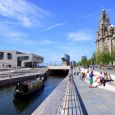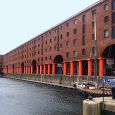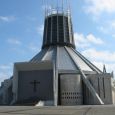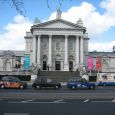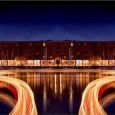Liverpool
Advertisement
By Air
Liverpools airport is John Lennon Airport, which is located just 13kms from the city centre. Although a fairly small airport, the terminal services regular daily flights from many cities in the United Kingdom, as well as a handful of destinations in mainland Europe.
By Rail
Express trains depart frequently from Londons Euston Station for the three hour trip to Liverpool. Frequent service is also available from Manchester, which is just 45 minutes away. Liverpools main train station is the Lime Street station, which is located in the northeast section of the city centre. Virgin Trains operate a very fast service from London using the new tilting Pendolino trains. Other rail operators which service Liverpool include Arriva Trains, Central Trains and First Great Western.
By Bus
National Express is the main coach company which runs frequent buses from Londons Victoria Coach Station every three hours. The journey from London takes around 4 hours 30 minutes. Buses regularly arrive from Manchester as well, which is a one hour ride away. All long-distance coaches arrive at Liverpools central station, located in the city centre.
By Car
Liverpool is easily accessible by road if you are driving from another city. It you are arriving from London, head north on the M1 before transferring to the M6. The motorway to Liverpool is the M62, which leads off of the M1. Drivers from the north should use the M58.
Advertisement
Albert Dock
On the waterfront southwest of the inner city is Albert Dock, superbly restored in 1992. Opened in 1846 by Prince Albert and closed in 1972 the inner-city docks of Liverpool were the second largest enclosed docks in Britain of that time, the first to be built without wood using only bricks and iron to reduce the danger of fire. Nearby the old landing stages are reminders of Liverpool's former glory, when luxury liners from America anchored here and the city was a profitable trading center.
A square block five stories high surrounds the harbor basin, where once cotton, tobacco and sugar were unloaded. The enormous brick buildings by the Victorian engineer Jesse Hartley (1824-1860) are built around an arcaded walkway, its cast Tuscan columns were capstans for mooring the ships. The decoratively restored warehouses with their luxury apartments, designer boutiques, offices, restaurants, cafes and museums are a prime example of "gentrification", a phenomena which can also be witnessed in London, Manchester and Glasgow, whereby decaying inner cities are restored to provide recreational amenities.
Tate Gallery
An acclaimed branch of the Tate Gallery in London has been established in the Albert Dock. As chance would have it the London Tate Gallery, which was founded at the end of the 19th C with a legacy from the sugar magnate Sir Henry Tate, found new accommodation in the warehouses where Tate stored the raw sugar before it was refined. The last connection with the inventor of the sugar cube ended in 1981 with the closure of the Tate & Lyle sugar refineries in Liverpool, a fate, which is only too familiar to this once thriving port.
Restoration was the work of Liverpool architect James Stirling who also extended the Tate Gallery on the bank of the Thames for the Turner Museum. The ground floor of the "Tate of the North" has three exhibition halls (total of 4,000sq.m. floor space), the first floor has three galleries dedicated to contemporary art. On the second floor are works on loan from the London Tate, on the upper floors are offices, lecture halls and artists' studios.
Roman Catholic Cathedral
Building began on the Roman-Catholic cathedral in 1928 only 0.5mi/0.5km from the Anglican cathedral. The original design was for a neo-Classical building, but only the crypt of this was completed. After the Second World War an architectural competition was held for the completion of the cathedral, the successful design - much more modest than the original plan, which would have produced the second largest church in Christendom, - was by Sir Frederick W. Gibberd, who had worked on the design of Heathrow airport.
Port Sunlight Heritage Centre
Port Sunlight is of interest for the part it played in the history of British industrial development. The Lever brothers had made a considerable fortune from soap and founded a model town for their workers on the estuary of the Mersey in 1888, similar to that of Cadbury near Birmingham. They built better schools and training centers. The Lady Lever Art Gallery has an excellent collection of Art Nouveau, 18th C furniture and Wedgewood porcelain, together with works by Turner and other English painters.
George Pier Head
To the north of the George Pier Head the traditional trio of harbor buildings can be seen: the Port of Liverpool Building (administration) in Portland stone designed by Arnold Thornley in 1907, the Cunard Building named after the Canadian Samuel Cunard (Cunard opened the first shipping line Liverpool-Halifax-Boston) and the granite Royal Liver Building by W.A. Thomas
Information not available
January - February -> 2(°C) - Winter
July - August -> 14(°C) - Summer
Advertisement

